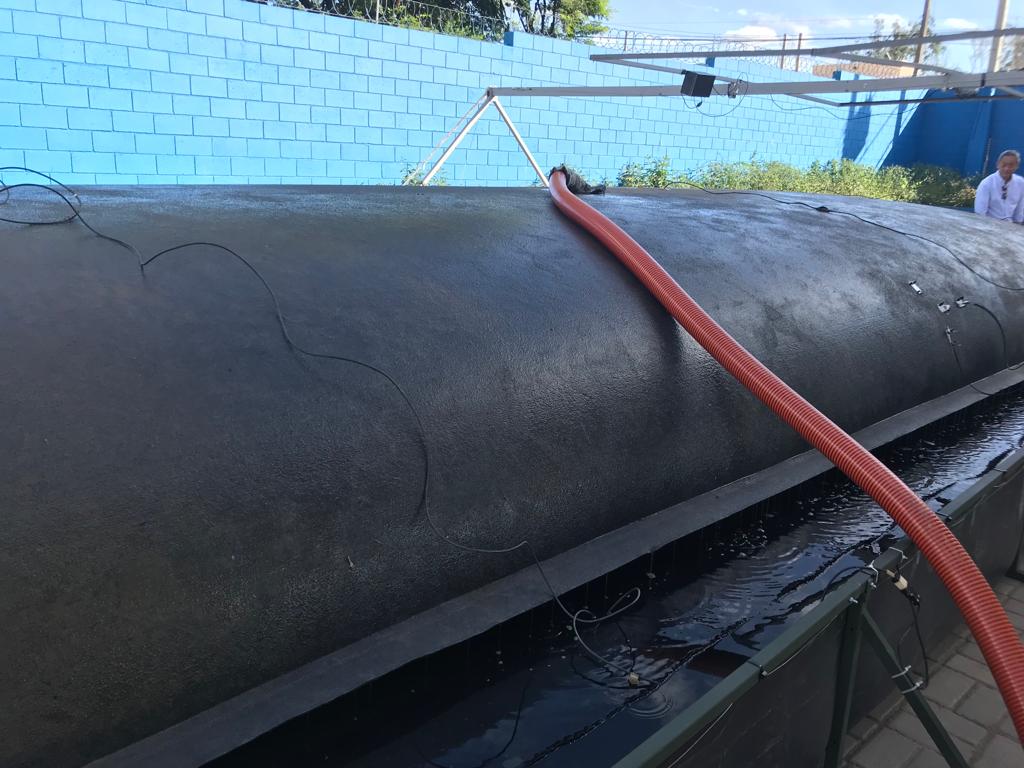Using geotextile tubes as dewatering technology may significantly contribute to sustainable treatment of sludge generated in different industries, such as the water industry. This is an economical alternative for dewatering sludge from a Water Treatment Plant (WTP), which prevents sludge from being directly deposited in water bodies and makes it possible to then transfer the sludge to landfills.
- Geotextile Tube
- Dewatering
- Sludge
Surface water sources have been increasingly mistreated by releasing debris, which is a result of population growth, industrial activities, and the disorderly occupation of protected areas [1]. Due to the low-quality conditions of water bodies, increasing quantities of chemical products need to be used to treat the water, thus increasing the generation of sludge. A Water Treatment Plant (WTP) sludge is a high-water content material, with a granulometric distribution of fine sediments. It originates mainly in decanters and filter washing, and its characteristics depend on different factors, such as the type and quality of crude water, chemical products used in treatment systems, and the operational conditions of the WTP [1][2][3].
As environmental awareness is raised and more stringent regulations related to the treatment of WTP sludge emerge, technologies that aim to dewater sludge to facilitate its treatment and disposal become increasingly more important. Approximately two decades ago, sludge dewatering was carried out almost exclusively with conventional technologies such as settling ponds, mechanical presses, and centrifuges[4]. Despite the various alternatives and technologies available on the market, the main obstacles to WTP sludge dewatering are the high cost and operational complexity [3]. In this context, geotextile tube technology emerged. It was used for the first time in the 1990s by Fowler et al. [5] for dewatering sludge from a sewage treatment plant.

Geotextile tubes foster the natural physical separation between the solid and liquid fraction of the sludge, in addition to possibly containing contaminants present in the sludge [6], showing, in some cases, a better performance compared to conventional dewatering technologies. The solid fraction can be transferred directly to sanitary landfills and the liquid fraction (effluent) can be returned to the interior of the system, or sent directly to water bodies, as long as it complies with environmental regulations, which, if not met, will require a secondary treatment [7].
Chemical conditioning of the sludge and the filter cake formation is a fundamental aspect to be considered in geotextile tubes dewatering. In order to improve the dewatering performance in geotextile tubes, several works have already been developed, using different treatments, test methodologies, residues or sludge, and polymers. Bourgès-Gastaud et al. [8]evaluated the dewatering of residues with different clay content using nonwoven geotextiles, showing the feasibility of using this type of geotextile in dewatering residues with fine granulometric characteristics. They also observed that the samples of residues with less than 25% of silt in the composition obtained less dewatering efficiency than the others, indicating that the sludge composition, and not the geotextile characteristics, determines the system’s dewatering efficiency.
Compared with other natural technologies of dewatering, geotextile tubes show a lower dependence on meteorological conditions, as there is a lower input of rainwater through the geotextile [9]. These systems can be manufactured in different sizes, are simple to transport and use, and are significantly more economical [6]. Geotextile tubes in the national and international panorama present great potential for application, making them an efficient and viable solution from a technical and economical point of view.
This entry is adapted from the peer-reviewed paper 10.3390/su12198129
References
- Cordeiro, J.S. Processamento de lodos de Estações de Tratamento de Água (ETAs). In Resíduos Sólidos do Saneamento: Processamento, Reciclagem e Diposição Final; Projeto PROSAB: Rio de Janeiro, Brazil, 2001; pp. 121–142.
- Reali, M.A.P. Principais características quantitativas e qualitativas do lodo de ETAs. In Noções Gerais de Tratamento e Disposição Final de Lodos de ETA; ABES/PROSAB: Rio de Janeiro, Brazil, 1999; pp. 21–39.
- Dantas, A.D.B.; Voltan, P.E.N. Métodos e Técnicas de Tratamento de Água, 3rd ed.; LDiBe: São Carlos, Brazil, 2017; p. 1246.
- Grzelak, M.D.; Maurer, B.W.; Pullen, T.S.; Bhatia, S.K.; RamaRao, B. A Comparison of Test Methods Adopted for Assessing Geotextile Tube Dewatering Performance. Geo-Front. 2011 Adv. Geotech. Eng. 2011, 2141–2151.
- Fowler, J.; Bagby, R.M.; Trainer, E. Dewatering sewage sludge with geotextile tubes. In Proceedings of the 49th Canadian Geotechnical Conference, St. John’s, NL, Canada, 23–25 September 1996; pp. 1–31.
- Lawson, C. Geotextile containment for hydraulic and environmental engineering. Geosynth. Int. 2008, 15, 384–427.
- Muthukumaran, A.; Ilamparuthi, K. Laboratory studies on geotextile filters as used in geotextile tube dewatering. Geotext. Geomembr. 2006, 24, 210–219.
- Bourgès-Gastaud, S.; Stoltz, G.; Sidjui, F.; Touze-Foltz, N. Nonwoven geotextiles to filter clayey sludge: An experimental study. Geotext. Geomembr. 2014, 42, 214–223.
- Guimarães, M.; Urashima, D.D.C.; Vidal, D.D.M. Dewatering of sludge from a water treatment plant in geotextile closed systems. Geosynth. Int. 2014, 21, 310–320.
